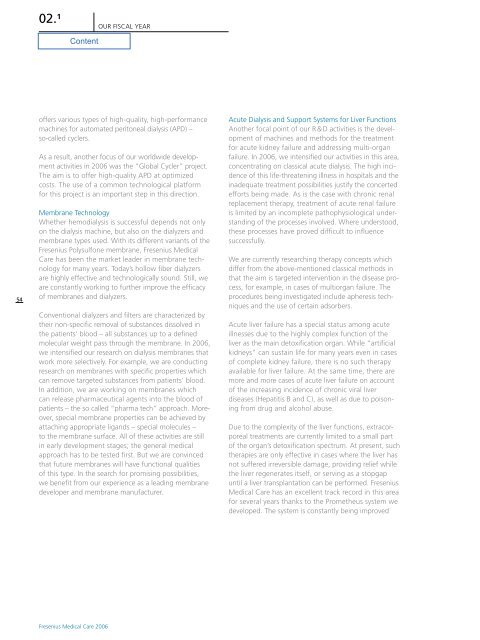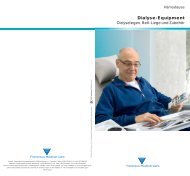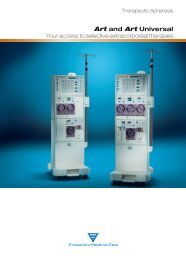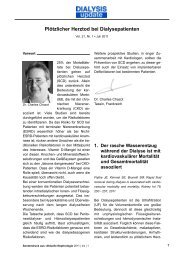Operations and Business Environment - Fresenius Medical Care
Operations and Business Environment - Fresenius Medical Care
Operations and Business Environment - Fresenius Medical Care
Create successful ePaper yourself
Turn your PDF publications into a flip-book with our unique Google optimized e-Paper software.
02. 1<br />
Our Fiscal year<br />
54<br />
offers various types of high-quality, high-performance<br />
machines for automated peritoneal dialysis (APD) –<br />
so-called cyclers.<br />
As a result, another focus of our worldwide development<br />
activities in 2006 was the “Global Cycler” project.<br />
The aim is to offer high-quality APD at optimized<br />
costs. The use of a common technological platform<br />
for this project is an important step in this direction.<br />
Membrane Technology<br />
Whether hemodialysis is successful depends not only<br />
on the dialysis machine, but also on the dialyzers <strong>and</strong><br />
membrane types used. With its different variants of the<br />
<strong>Fresenius</strong> Polysulfone membrane, <strong>Fresenius</strong> <strong>Medical</strong><br />
<strong>Care</strong> has been the market leader in membrane technology<br />
for many years. Today’s hollow fiber dialyzers<br />
are highly effective <strong>and</strong> technologically sound. Still, we<br />
are constantly working to further improve the efficacy<br />
of membranes <strong>and</strong> dialyzers.<br />
Conventional dialyzers <strong>and</strong> filters are characterized by<br />
their non-specific removal of substances dissolved in<br />
the patients‘ blood – all substances up to a defined<br />
molecular weight pass through the membrane. In 2006,<br />
we intensified our research on dialysis membranes that<br />
work more selectively. For example, we are conducting<br />
research on membranes with specific properties which<br />
can remove targeted substances from patients’ blood.<br />
In addition, we are working on membranes which<br />
can release pharmaceutical agents into the blood of<br />
patients – the so called “pharma tech” approach. Moreover,<br />
special membrane properties can be achieved by<br />
attaching appropriate lig<strong>and</strong>s – special molecules –<br />
to the membrane surface. All of these activities are still<br />
in early development stages; the general medical<br />
approach has to be tested first. But we are convinced<br />
that future membranes will have functional qualities<br />
of this type. In the search for promising possibilities,<br />
we benefit from our experience as a leading membrane<br />
developer <strong>and</strong> membrane manufacturer.<br />
Acute Dialysis <strong>and</strong> Support Systems for Liver Functions<br />
Another focal point of our R & D activities is the development<br />
of machines <strong>and</strong> methods for the treatment<br />
for acute kidney failure <strong>and</strong> addressing multi-organ<br />
failure. In 2006, we intensified our activities in this area,<br />
concentrating on classical acute dialysis. The high incidence<br />
of this life-threatening illness in hospitals <strong>and</strong> the<br />
inadequate treatment possibilities justify the concerted<br />
efforts being made. As is the case with chronic renal<br />
replacement therapy, treatment of acute renal failure<br />
is limited by an incomplete pathophysiological underst<strong>and</strong>ing<br />
of the processes involved. Where understood,<br />
these processes have proved difficult to influence<br />
successfully.<br />
We are currently researching therapy concepts which<br />
differ from the above-mentioned classical methods in<br />
that the aim is targeted intervention in the disease process,<br />
for example, in cases of multiorgan failure. The<br />
procedures being investigated include apheresis techniques<br />
<strong>and</strong> the use of certain adsorbers.<br />
Acute liver failure has a special status among acute<br />
illnesses due to the highly complex function of the<br />
liver as the main detoxification organ. While “artificial<br />
kidneys” can sustain life for many years even in cases<br />
of complete kidney failure, there is no such therapy<br />
available for liver failure. At the same time, there are<br />
more <strong>and</strong> more cases of acute liver failure on account<br />
of the increasing incidence of chronic viral liver<br />
diseases (Hepatitis B <strong>and</strong> C), as well as due to poisoning<br />
from drug <strong>and</strong> alcohol abuse.<br />
Due to the complexity of the liver functions, extracorporeal<br />
treatments are currently limited to a small part<br />
of the organ’s detoxification spectrum. At present, such<br />
therapies are only effective in cases where the liver has<br />
not suffered irreversible damage, providing relief while<br />
the liver regenerates itself, or serving as a stopgap<br />
until a liver transplantation can be performed. <strong>Fresenius</strong><br />
<strong>Medical</strong> <strong>Care</strong> has an excellent track record in this area<br />
for several years thanks to the Prometheus system we<br />
developed. The system is constantly being improved<br />
<strong>Fresenius</strong> <strong>Medical</strong> <strong>Care</strong> 2006








